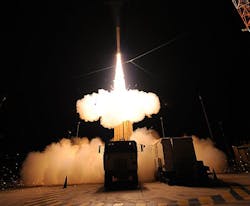Lockheed Martin nets $124.6 million contract for critical ballistic missile defense components
HUNTSVILLE, Ala., 13 Aug. 2014.Missile defense experts at the Lockheed Martin Corp. Missiles and Fire Control segment in Dallas will provide ground-based subsystems for a critical U.S. ballistic missile defense system under terms of a $124.6 million contract announced last week.
Officials of the U.S. Missile Defense Agency (MDA) are asking Lockheed Martin to provide launchers, support equipment, fire control and communications, and launcher spares for the Terminal High Altitude Area Defense (THAAD) ballistic missile defense system.
THAAD is designed to shoot down short-, medium-, and intermediate-range ballistic missiles in their terminal phase using a hit-to-kill kinetic warhead. The missile relies on the kinetic energy of the impact to destroy the incoming missile.
The system is a key element of the U.S. ballistic missile defense system to defend the continental United States, its deployed forces, friends, and allies against ballistic missiles of all ranges and in all phases of flight.
Related: Missile Defense Agency looks to Lockheed Martin for technology upgrades to THAAD
THAAD consists of five major components: launchers, interceptors, a radar, THAAD fire control and communications (TFCC) units, and THAAD-specific support equipment.
Lockheed Martin started developing the THAAD system in 1992, and first tested the system three years later. The first THAAD tests that hit their targets were in 1999, after the first six tests missed their targets. THAAD missiles, which have a maximum range of about 125 miles, are expected to hit incoming ballistic missile warheads as high as 93 miles above the Earth's surface.
THAAD uses an X-Band radar from the Raytheon Co. Integrated Air Defense segment in Andover, Mass. Other key subcontractors are Boeing, Aerojet, Rocketdyne, Honeywell, BAE Systems, and MiltonCAT.
Related: U.S. Army orders more THAAD equipment from Lockheed Martin
Deployment of the THAAD system began in 2008, and is nearing completion. On this contract Lockheed Martin will do the work in Dallas; Lufkin, Texas; Huntsville, Ala.; Sunnyvale, Calif.; and Camden, Ark., and should be finished by August 2017.
For more information contact Lockheed Martin Missiles and Fire Control online at www.lockheedmartin.com, or the Missile Defense Agency at www.mda.mil.

